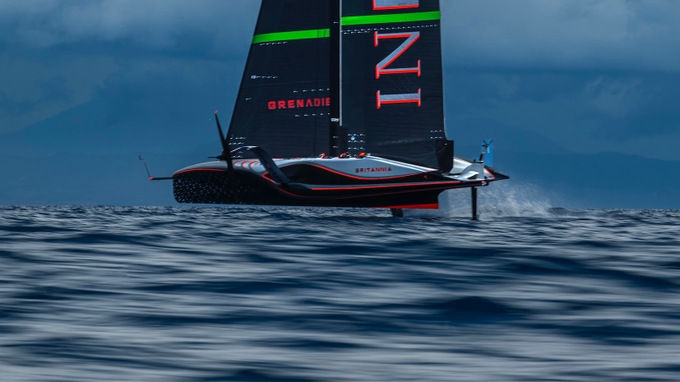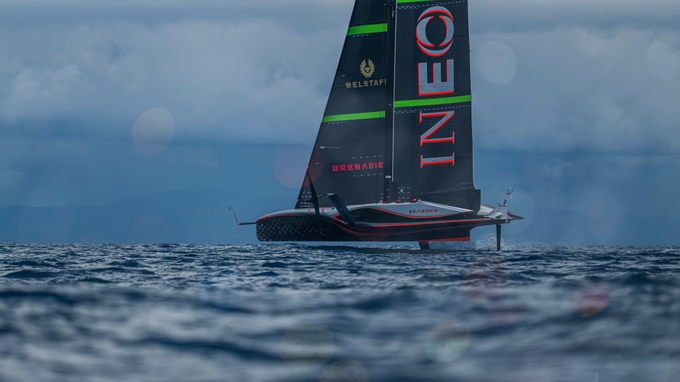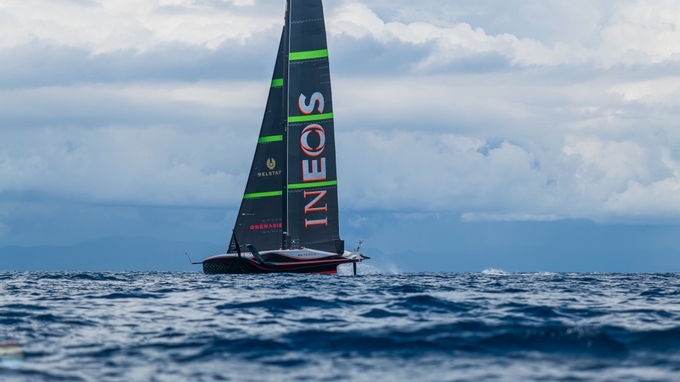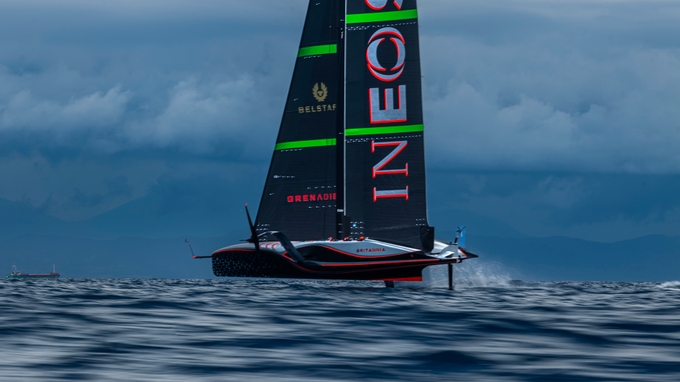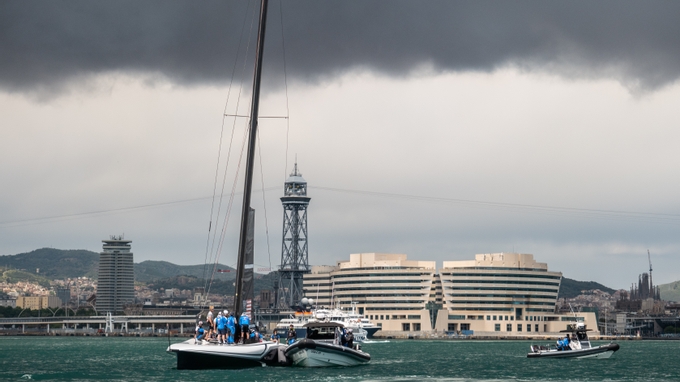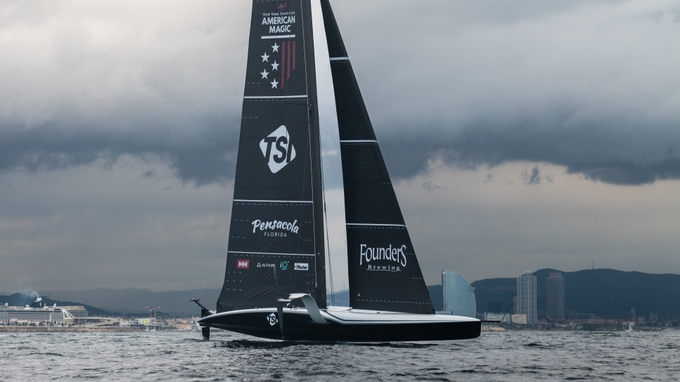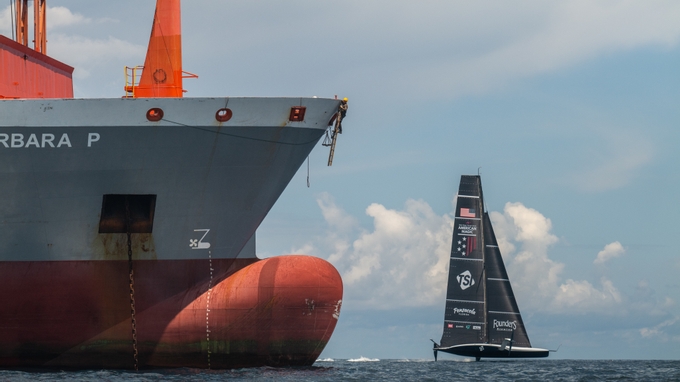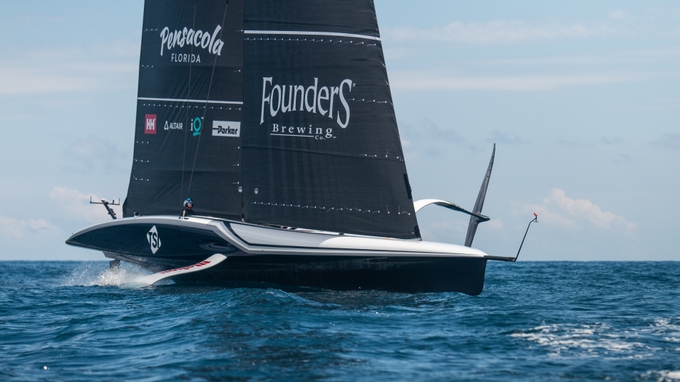BRITISH AND AMERICANS DODGE THUNDER & LIGHTNING
Dreams of shorts and fast-drying T-shirts in the Louis Vuitton 37th America’s Cup were on hold again as the British and American teams busted out the drysuit spray-tops as summer resolutely waits behind a very slow-moving Atlantic high with Isobars wider than the length of the Mississippi. Apocalyptic cloud cover dominated the racetrack whilst cells of thunder, accompanied by lightning streaks, delayed dock-out and made the meteorologists work hard for their living.
After a few days shoreside, INEOS Britannia resumed their training with a very clear goal to get these downrange conditions ticked-off in terms of sail cross-overs, flight speeds and moding but had to tow almost seven miles initially after dock-out to find usable wind patches. The breeze was up, down and shifting wildly right at the point where the British started sailing with the big M1 double-skinned mainsail hoisted and the equally enormous J1 but it wasn’t to be. The wind shut down to almost nothing and sailing was halted.
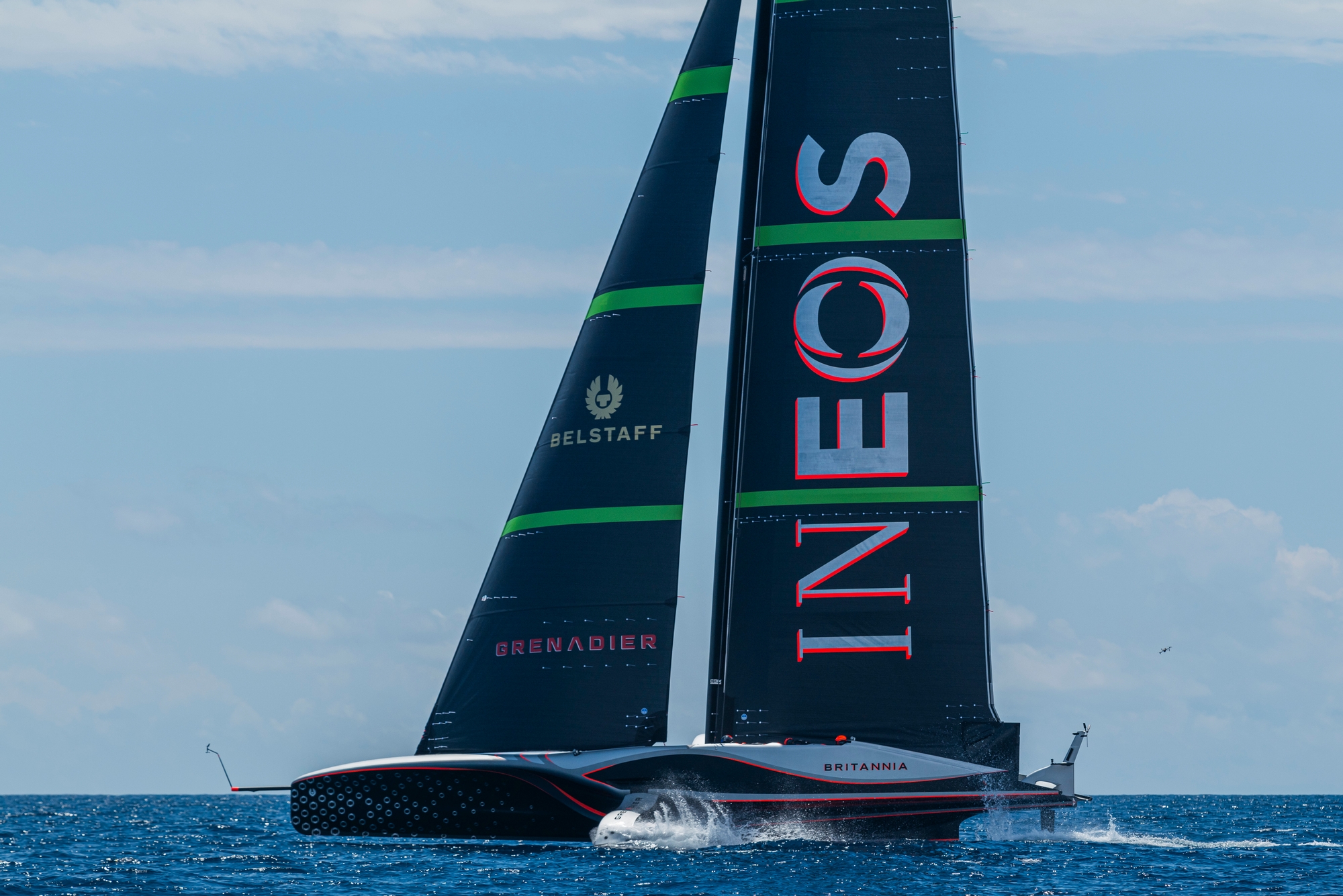
An hour later, the breeze returned under the clouds and INEOS Britannia were up impressively in a shot, looking powerful under the full sail plan and the recon team noted that they absolutely ‘drilled’ the tacks (see below). ‘RB3’ – the codename for the team’s AC75 will be christened this Saturday and no doubt Sir Jim Ratcliffe will be more than pleased with not only the numbers being generated but also the overall performance of both the boat and the team.
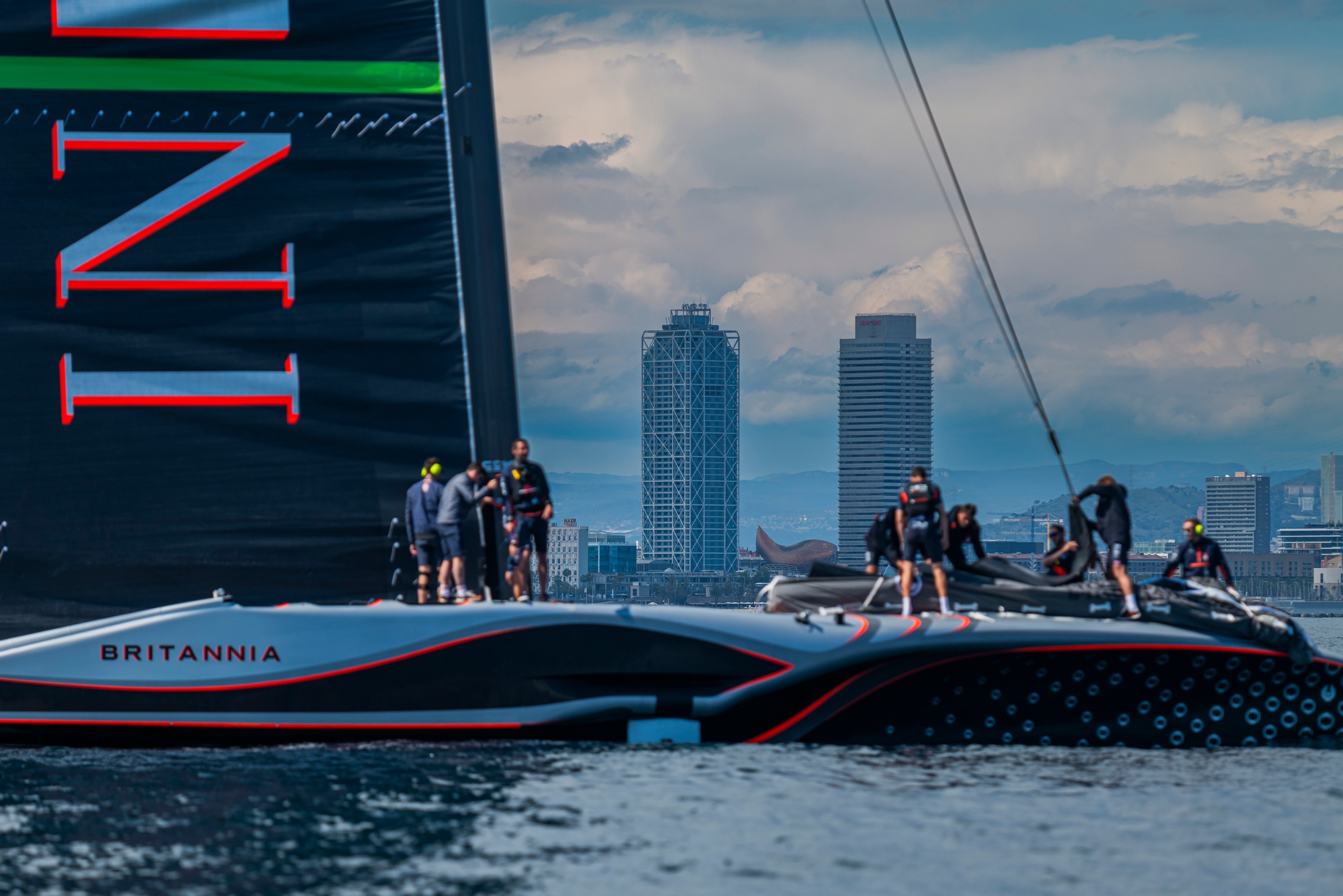
The Challenger of Record are looking impressive all over, from top to bottom and the technological runway now from here to the Cup, with the support of Mercedes Applied Science will be key to their success come race time. Ben Cornish, one of the truly outstanding sailors at INEOS Britannia who would make any team in this cycle, spoke about the technology that’s on its way, saying: “There's a lot to come. Every single day and into the night the boat is moving forward. I guess where you see everyone's package at the moment is nowhere near where they will end up for racing, you know they’re still very much early products and there's so much more potential to come out of everyone's boat so it's a huge thing to consider, how much you need to keep moving forward.”
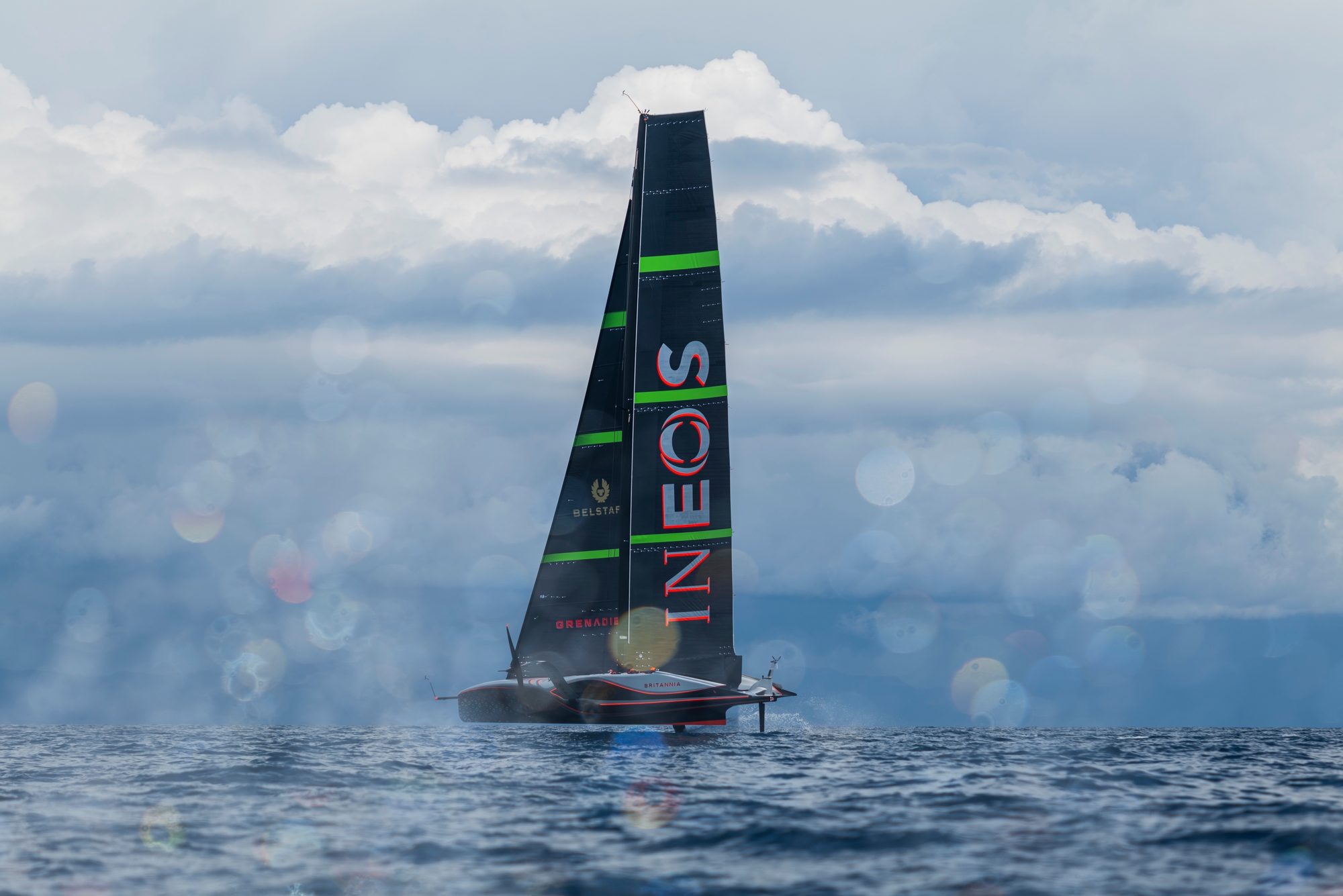
As a cyclor sat just behind the helm and possibly with more than just a power-output role, Ben talked knowledgably about the recumbent cyclors seen on the NYYC American Magic boat, saying: “I think having listened to a lot of the other teams talk about it, it’s something that I'm sure everyone considered - we certainly did - we looked at the numbers and added up the benefit versus the losses and obviously we ended up where we are but it's not a massive surprise to see one of the teams end up there so yeah we'll have to see how it plays out for the racing, and who got it right.”
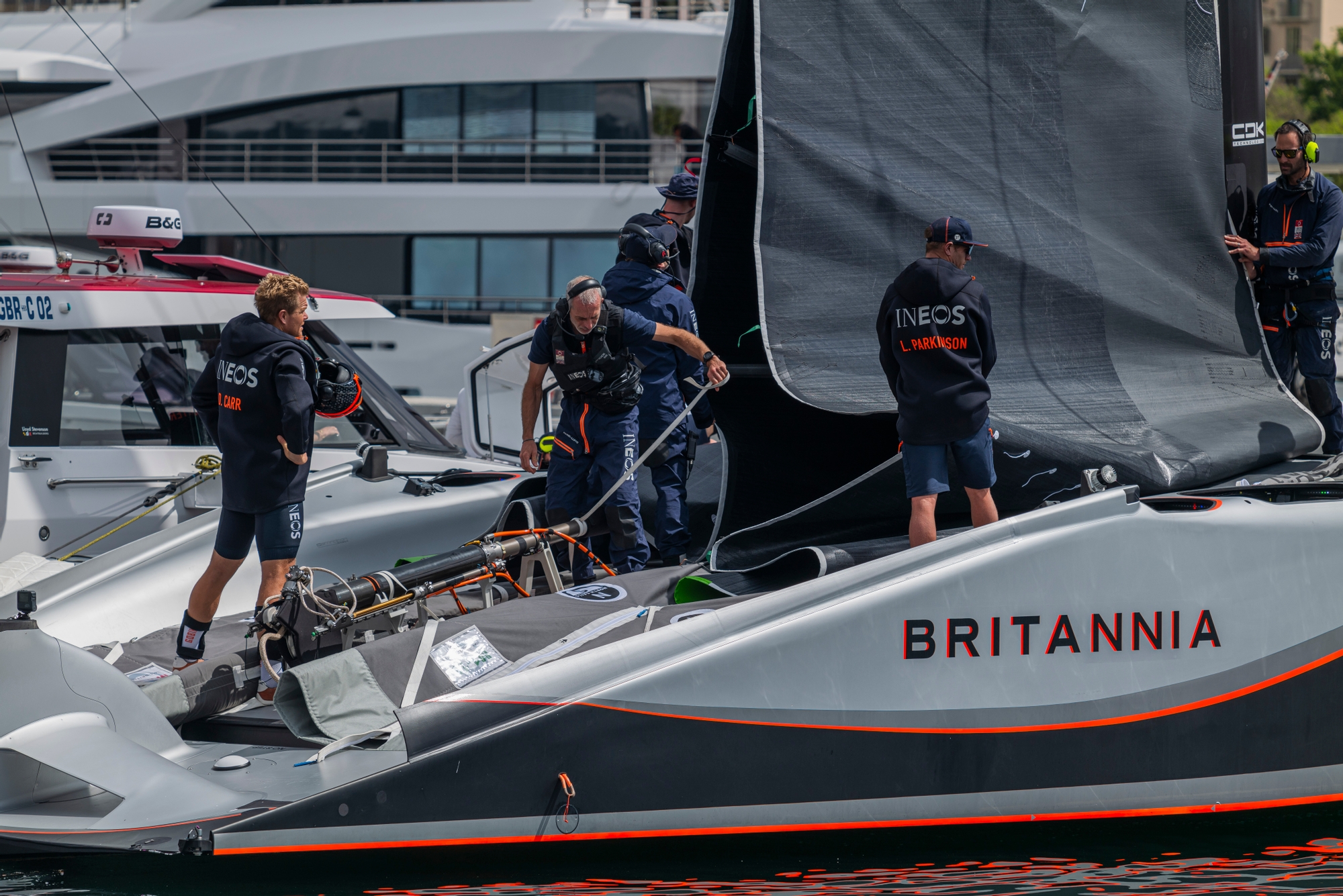
The feeling is very much that the British are right on the money here in this Louis Vuitton America’s Cup and the body language around the base is super-positive. Ben summed it up perfectly saying: “The mood is great. It’s good for the team to be out here and now pushing. The smaller boats were great, but this is obviously the end product, and this is what we're all here for so yeah, the morale is really good, people working hard and we're moving forward.” INEOS Britannia are scheduled to sail again on both Friday and Saturday.
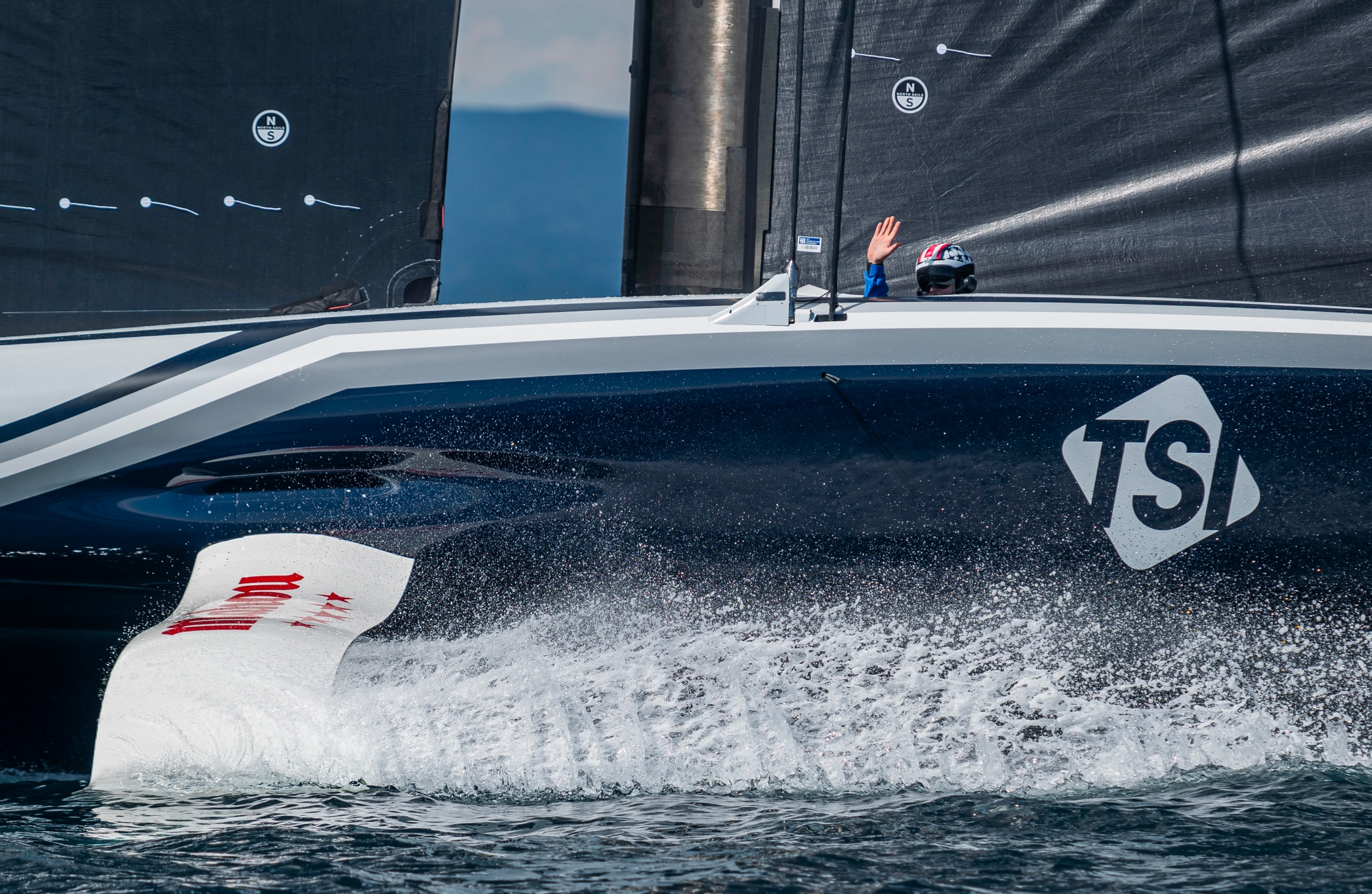
Holding in the dock for an hour longer than INEOS Britannia was NYYC American Magic who decided to let the thunder and lightning pass into the distance before going sailing initially down at the Freeport area to the south of the Barcelona harbour entrance. Here they picked up a trickle of breeze and got flying with their big MN2-1 mainsail and J1 jib, desperate to build up some foil data via the cameras mounted on the foil arms. Largely they were successful but this was, in essence, the only useful period of the day as the wind shut down after a stint of just 25 minutes.

Yet again, the tech teams were onboard looking at the jib sheeting arrangement which clearly isn’t quite right at the moment and has been dogging recent sessions but they released the sailors to try and get some more time in a fading breeze that was down to just 6 knots and shifting wildly. Unfortunately, in those conditions, tacking was an impossibility and the boat wallowed to displacement with the tech team back onboard again looking at the pesky jib system.
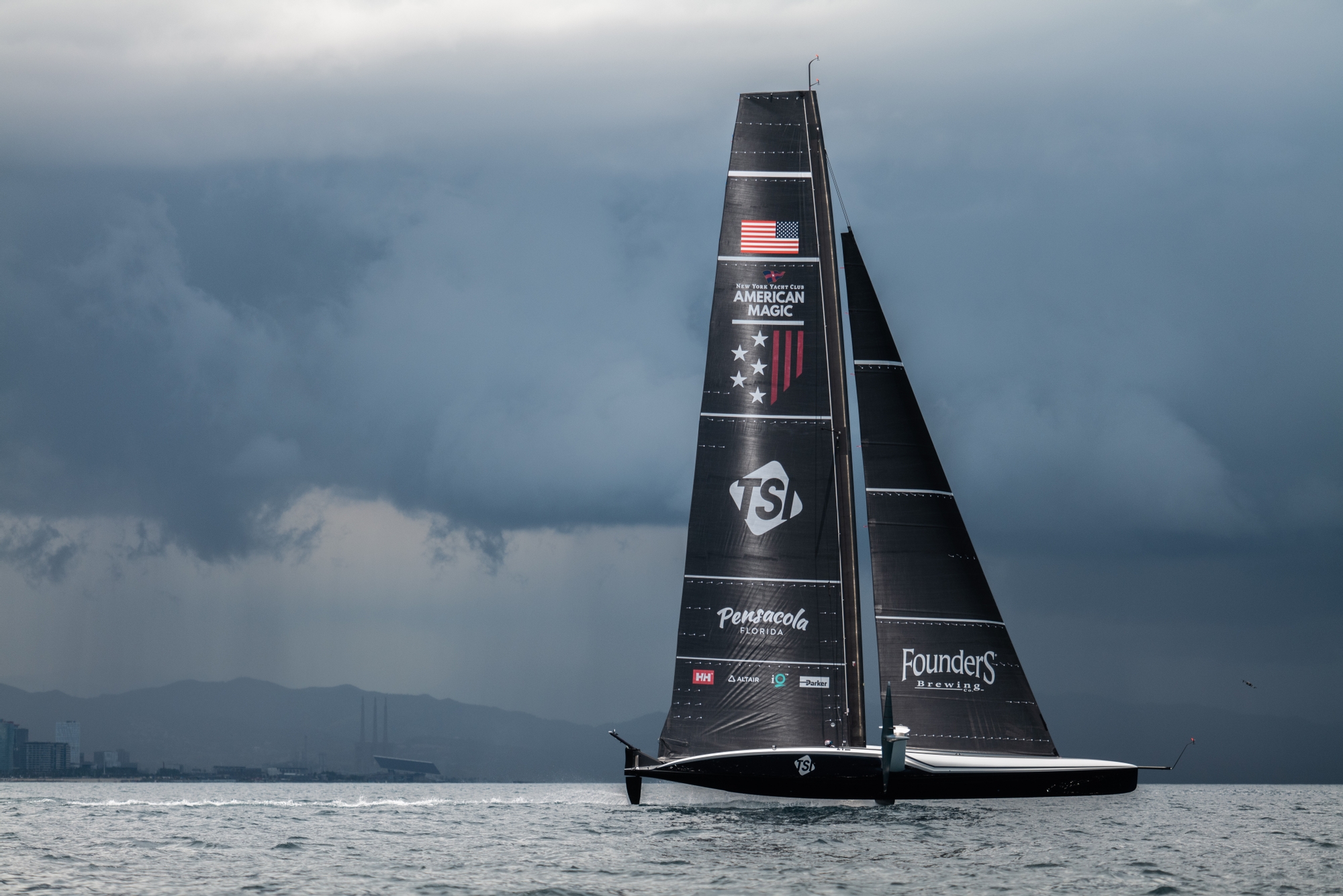
Several tow-to-fly runs were attempted but a 180 degree shift and the wind below 5 knots ended the day and the team towed home. Better days to come as Mike Menninger, trim and, we found out, alternate flight controller tack to tack commented: “It was a tricky day, we had a lot of rain and possible lightning in the early part of the day so we were on hold on the dock and then we thought we’d get a building southerly throughout the rest of the afternoon and so we went out and unfortunately it was a little bit lighter than we thought, but we still had some good later sailing, so pretty good.”
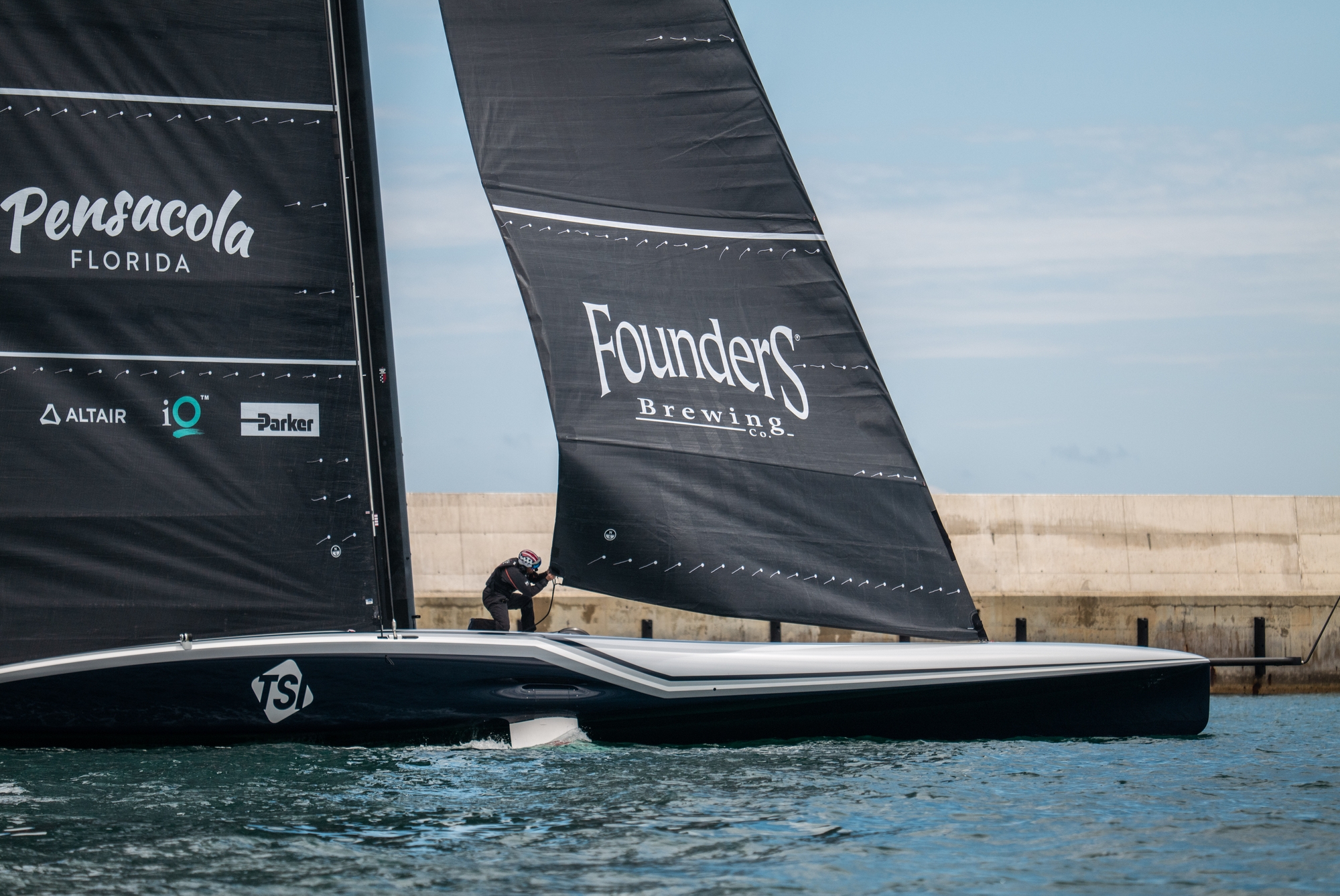
Talking about the importance that the design team have placed on light air performance, Mike gave a clue to the thinking in the aero, low volume design of ‘Patriot’ saying: “It's a massive part, it's probably the same for all the teams, I think the hull design, the sails everything, we all know Barcelona has the ability to be quite light with some sea state so I think a big part of our design package focused on lighter air.”
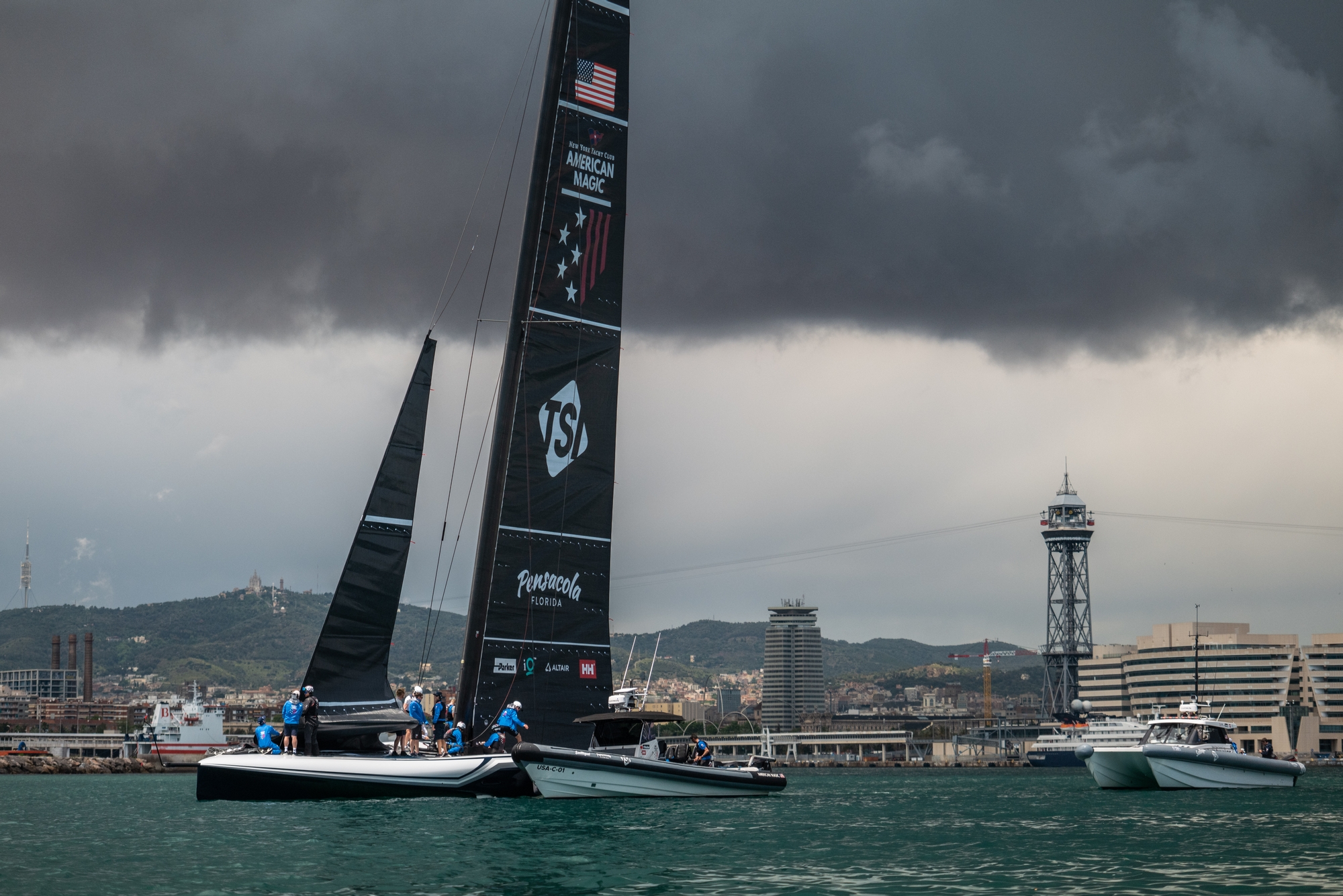
Better days to come for sure for NYYC American Magic who will be out early on Friday to make up for two rather frustrating days of training in Barcelona with an improving weather forecast – fingers crossed. (Magnus Wheatley)
On-Water Recon Report – NYYC American Magic: American Magic rolled out ‘Patriot’ at 10:20 and craned in half an hour later. It was noted that the small endplates on the starboard wingtips have been removed. Further maintenance was carried out on the jib sheeting system, followed by work on the Cunningham and mast rotation systems. A spell of rain put work on the yacht on pause, before clearing up for FCS checks, and mast rotation testing with cyclors in their pods.
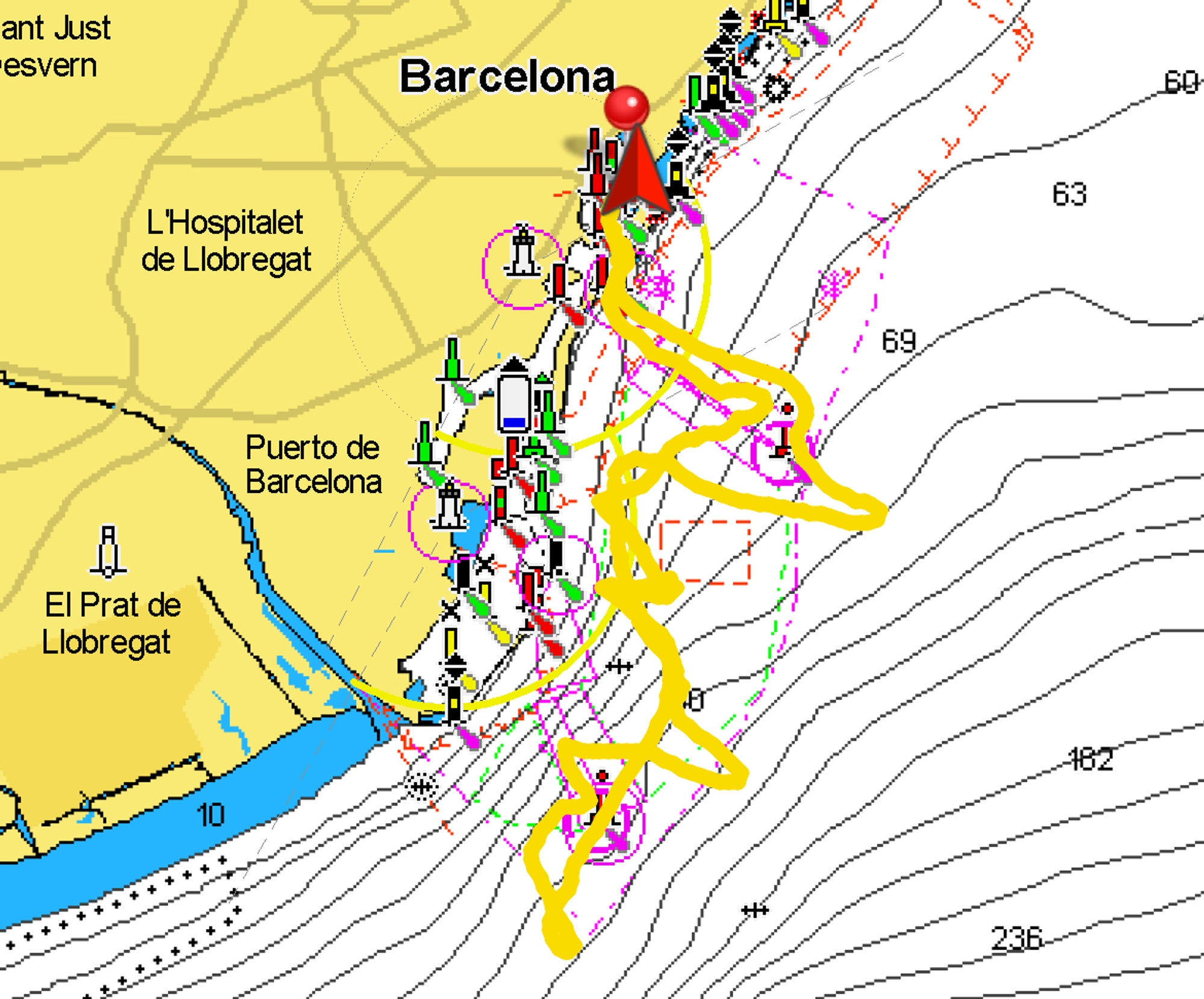
The team docked out at 13:40, with the MN2-1 mainsail and J1-1 jib hoisted under the breakwater by 14:00. Sailing commenced at 14:20 under an average windspeed of 9 knots, allowing Patriot to take off at an estimated 75 TWA. The team sailed a 25-minute stint under the Freeport breakwater, drilling light air manoeuvres and take offs. Tech crew jumped onboard to work on the jib system, before taking off again in approximately 6 knots wind speed. The crew were unable to complete a foil-to-foil tack and did not find the wind to take-off again. A battery change was carried out as more work on the jib system was observed, with technicians below deck.
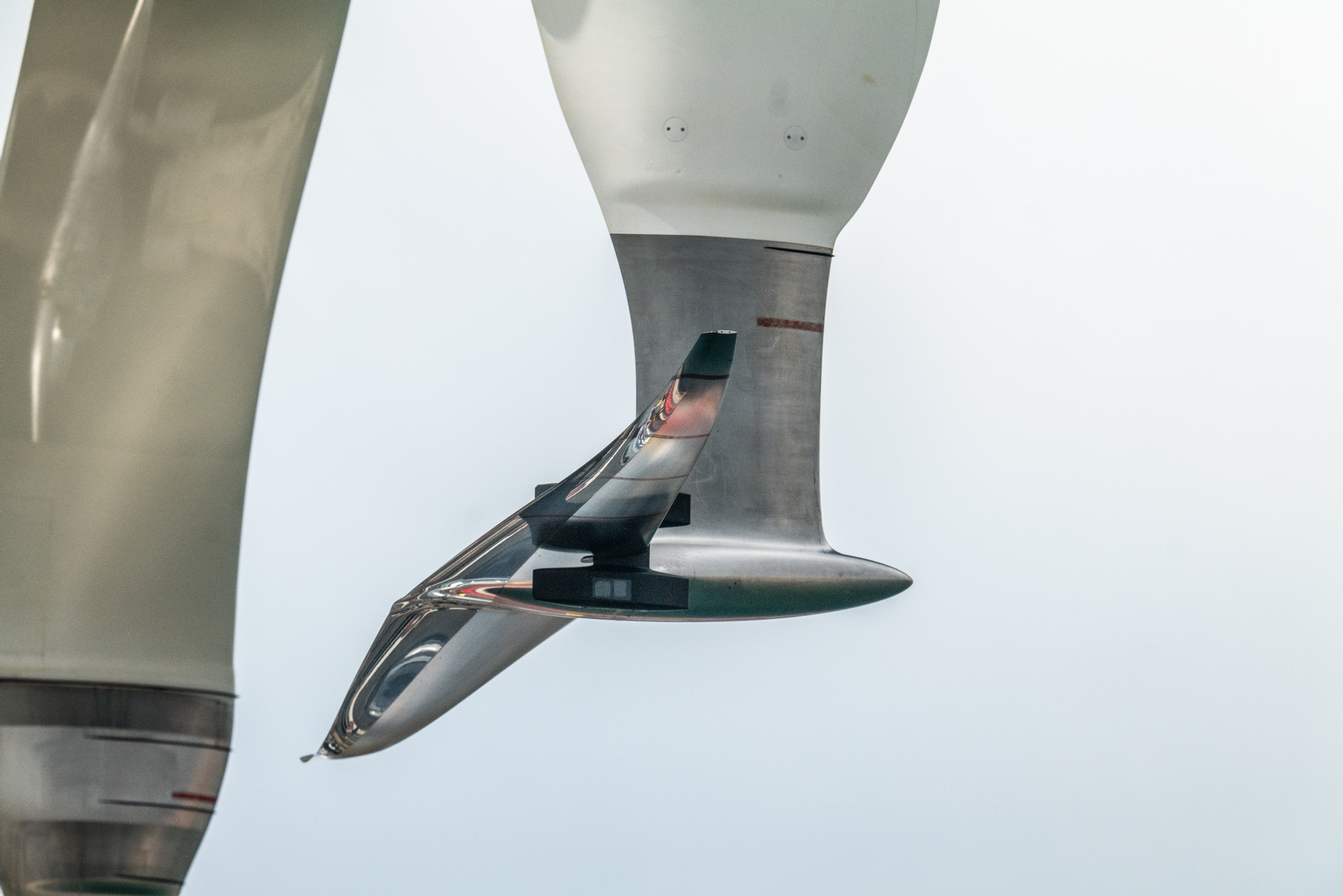
By 16:00, the wind dropped below 5 knots and swung way to the right, a 180-degree shift. Patriot was tow started a couple of times, but not able to maintain flight for more than a few minutes. The decision was made to return to base and end the day, with sails dropped by 16:40.
The team docked in by 16:45 after three hours on the water, of which 38 minutes were productive sailing (the team spent more time sailing in displacement and on the towline). Eight manoeuvres were performed, of which three were fully foiling.
On-Water Recon Report – INEOS Britannia: The British rolled out RB3 at 08:30 today, craned in at 09:05 and after some regular checks and maintenances on the different aero and flight control systems, dock-out was at 11:35. Foil cameras were removed on the last sailing session but today just the camera on starboard side foil was seen installed again.
RB3 was towed outside the harbour with one of the chase boats when a storm with rain, lightning and thunder was coming from a 240º direction and many clouds with rain could be seen in the north direction. When looking offshore into a 150-180º direction the sky was clean. RB3 was towed for 7 miles in that direction and then stopped to hoist sails. Mainsail MN1 was hoisted and paired to a J1 jib.
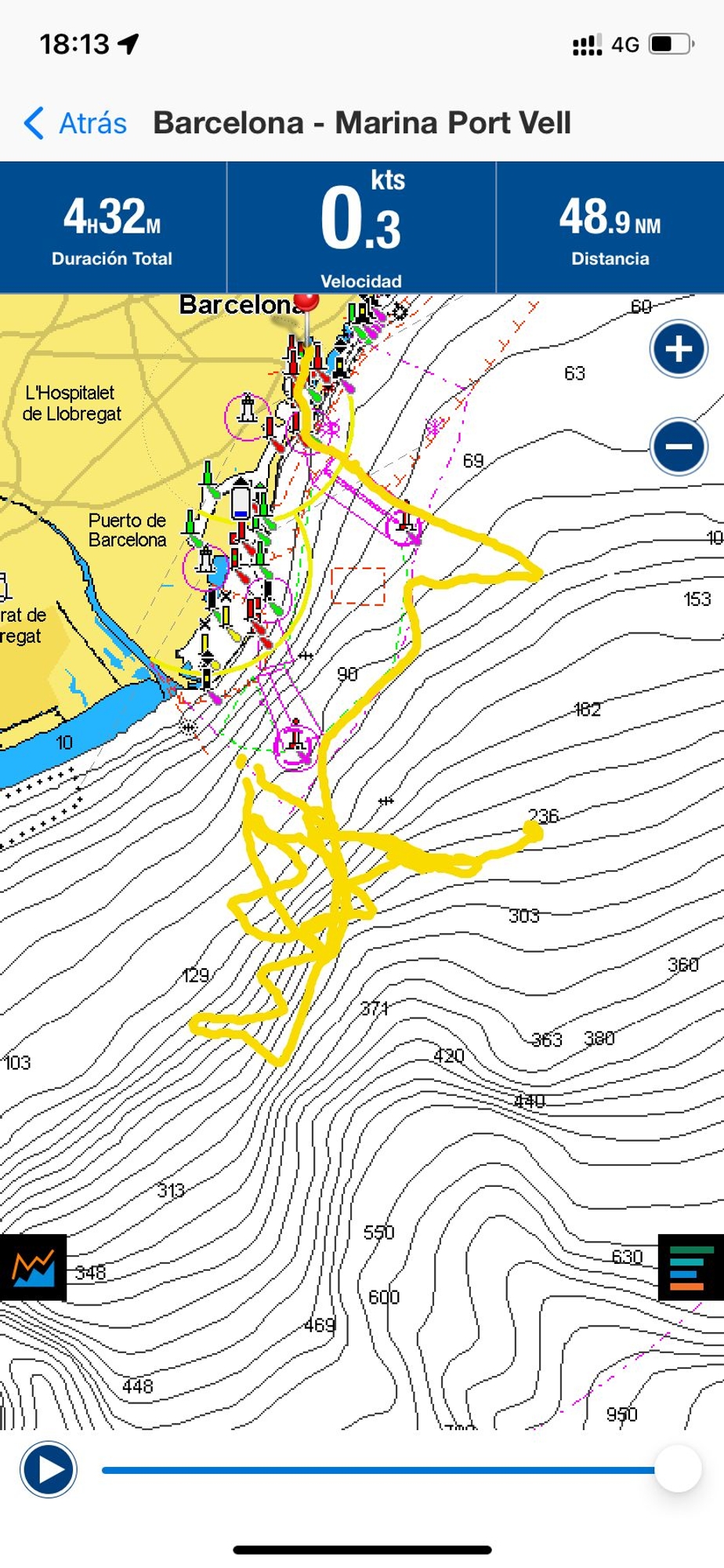
The wind was 5-7 knots TWD 170º@12:20 and the sea state running at 0.5-0.9 m. When RB3 started sailing, the wind dropped to 3-4 knots and it was not until 13:25 that it picked up to 7-8 knots and the British AC75 could start sailing.
A long upwind of almost 20 minutes was completed with 7 tacks drilled through. These tacks were basically the strong part of the sailing session from a foiling perspective, and we could see how different approaches to this manoeuvre were done. When the wind was very light it seemed like they tried to bear away a little bit to gain speed, take a bit of height, turn fast and delay dropping the windward arm as late as possible.
Today also we saw long straight-lines in displacement mode working for the take-off and we had the feeling that with the wave state (0.5 to 0.9 m), the boat need a bit more speed to make the take-off compared to the last day where they had 0.3 to 0.4m. (Both days in the wind bottom range).
A full cyclor swap was done at 14:40, two hours after the sails were hoisted. INEOS Britannia dropped sails at 16:15 and dock in was done at 16:50.
